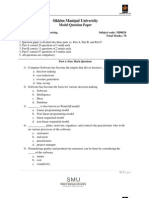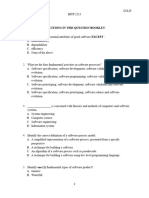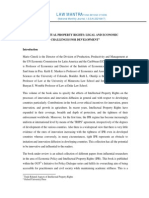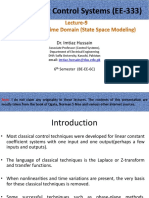Lab 3
Uploaded by
Devanshi GuptaLab 3
Uploaded by
Devanshi GuptaEXPERIMENT - 3
Aim:
To identify the various requirement development activities viz. elicitation, analysis, specification,
validation and management for the given scenarios.
Tools/Apparatus: None
Theory:
Requirement engineering produces a specification of what a system should do. The intention of
requirement engineering is to provide a clear definition of requirement of the systems. This phase is a
very important phase because, if the customer requirements are not clearly understood, the ambiguity
can get into the other phase of the development. To avoid such issues, requirement has to be elicited
using the right elicitation techniques, to be analyzed effectively, specified clearly and verified
thoroughly.
All activities are collectively termed as requirement development activities.
Procedure:
1) Study the tutorial paper “Software Requirements.pdf”.
2) Identify the requirement development activities associated with each of the
following scenarios.
a) Joe is creating an online survey questionnaire for requesting user feedback
on the desired features of the application to be developed.
b) Mark is preparing a formal document which includes all of the desired
features identified by the survey.
c) Jack identified an incomplete requirement statement.
d) Jones is identifying all security related requirement and separating them
from the performance related requirements.
e) Merlin a team member is sent to client to observe the business case and
collect typical user requirements.
f) Leo is team member is working on requirement and ensuring that
requirement collected should not be vague and unclear.
g) Lee is conducting a facilitated meeting with the stakeholder to capture the
requirements.
h) Amit a team member is distributing questionnaires to stack holder for
gathering user requirements.
i) Client requests a change in the current user interface to team leader.
Scenario Requirement Development Activities
a)
b)
c)
d)
e)
f)
g)
h)
i)
You might also like
- PMI ACP - Difficult Question Bank - AnswersNo ratings yetPMI ACP - Difficult Question Bank - Answers35 pages
- IT4304: Rapid Software Development: University of Colombo, Sri LankaNo ratings yetIT4304: Rapid Software Development: University of Colombo, Sri Lanka8 pages
- IT3203 Software Engineering 1: University of Colombo, Sri LankaNo ratings yetIT3203 Software Engineering 1: University of Colombo, Sri Lanka10 pages
- COT-216 and IT-313 Software Engg Lab QuestionsNo ratings yetCOT-216 and IT-313 Software Engg Lab Questions16 pages
- ISTQB Foundation Certificate End of Module 3 Quiz QUESTIONS 2911838No ratings yetISTQB Foundation Certificate End of Module 3 Quiz QUESTIONS 29118384 pages
- c8-r3: Advanced Software Engineering Note: 1. 2.No ratings yetc8-r3: Advanced Software Engineering Note: 1. 2.2 pages
- MI0024 Software Engineering-Model Question PaperNo ratings yetMI0024 Software Engineering-Model Question Paper7 pages
- IT3205 - Fundamentals of Software Engineering: University of Colombo, Sri LankaNo ratings yetIT3205 - Fundamentals of Software Engineering: University of Colombo, Sri Lanka5 pages
- Course Code & Title: 18CSE313T - : Product Management: Fundamentals & Practical ApplicationNo ratings yetCourse Code & Title: 18CSE313T - : Product Management: Fundamentals & Practical Application9 pages
- Mid Exam_FIT204_2022_June_815a5dbaf9d35e8388331612900313b2No ratings yetMid Exam_FIT204_2022_June_815a5dbaf9d35e8388331612900313b27 pages
- Time Allowed: 3 Hours Full Marks: 70: December 2018No ratings yetTime Allowed: 3 Hours Full Marks: 70: December 20182 pages
- Mid Exam_FIT204_b89fc8410a3251cd0344ba970cee0d5fNo ratings yetMid Exam_FIT204_b89fc8410a3251cd0344ba970cee0d5f10 pages
- Mba MB 401 Project Management and Entrepreneurship Development 2012No ratings yetMba MB 401 Project Management and Entrepreneurship Development 20124 pages
- Software Engineering MCQ 2 Final With AnswersNo ratings yetSoftware Engineering MCQ 2 Final With Answers18 pages
- COT-216 and IT-313 Software Engg Lab Questions0% (1)COT-216 and IT-313 Software Engg Lab Questions18 pages
- I.C.T 11TH Grade Second Term Note EditedNo ratings yetI.C.T 11TH Grade Second Term Note Edited21 pages
- SPC 2202 Object Oriented Analysis and Design Year II Semester INo ratings yetSPC 2202 Object Oriented Analysis and Design Year II Semester I3 pages
- 140512-140703-Object Oriented Analysis Design and UmlNo ratings yet140512-140703-Object Oriented Analysis Design and Uml2 pages
- Mba MB 401 Project Management and Entrepreneurship Development 2011No ratings yetMba MB 401 Project Management and Entrepreneurship Development 20117 pages
- Testbank Software Engineering Final 2021 SpringNo ratings yetTestbank Software Engineering Final 2021 Spring12 pages
- Java / J2EE Interview Questions You'll Most Likely Be AskedFrom EverandJava / J2EE Interview Questions You'll Most Likely Be AskedNo ratings yet
- Salesforce Certified Platform Developer I CRT-450 Exam PreparationFrom EverandSalesforce Certified Platform Developer I CRT-450 Exam PreparationNo ratings yet
- 10 9MA0 01 9MA0 02 A Level Pure Mathematics Practice Set 10No ratings yet10 9MA0 01 9MA0 02 A Level Pure Mathematics Practice Set 105 pages
- Presentation Report On Union Bank of India: Submitted ToNo ratings yetPresentation Report On Union Bank of India: Submitted To23 pages
- Software Engineering: User Interface DesignNo ratings yetSoftware Engineering: User Interface Design14 pages
- Intellectual Property Rights: Legal and Economic Challenges For DevelopmentNo ratings yetIntellectual Property Rights: Legal and Economic Challenges For Development4 pages
- Cryptographic Algorithm Validation ProgramNo ratings yetCryptographic Algorithm Validation Program21 pages
- PROPOSED CONSTRUCTION OF 2 CLASSROOMS AT NDEGE PRIMARY SCHOOLNo ratings yetPROPOSED CONSTRUCTION OF 2 CLASSROOMS AT NDEGE PRIMARY SCHOOL3 pages
- iLS - English - Y7 - T1 - Endoftermtest - Set 2No ratings yetiLS - English - Y7 - T1 - Endoftermtest - Set 214 pages
- Cathodic Protection of Reinforced Concrete Distance LearningNo ratings yetCathodic Protection of Reinforced Concrete Distance Learning4 pages
- RFID Based Smart Lock Implementation: Computer Engineering Department, College of Engineering, Al-Iraqia University, IraqNo ratings yetRFID Based Smart Lock Implementation: Computer Engineering Department, College of Engineering, Al-Iraqia University, Iraq5 pages
- Maratha Mandir Babasaheb Gawade Institution of Management Studies Mms Semester Ii Subject - Analysis of Financial StatementNo ratings yetMaratha Mandir Babasaheb Gawade Institution of Management Studies Mms Semester Ii Subject - Analysis of Financial Statement9 pages
- What Is Cardiac Axis ECG Interpretation Geeky MedicsNo ratings yetWhat Is Cardiac Axis ECG Interpretation Geeky Medics1 page

























































































